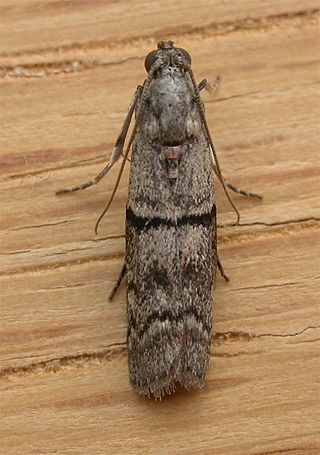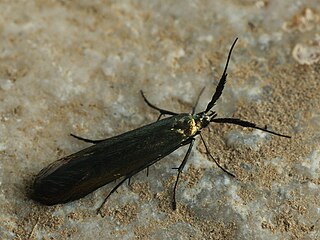
Moths are a group of insects that includes all members of the order Lepidoptera that are not butterflies. They were previously classified as suborder Heterocera, but the group is paraphyletic with respect to butterflies and neither subordinate taxon is used in modern classifications. Moths make up the vast majority of the order. There are approximately 160,000 species of moth, many of which have yet to be described. Most species of moth are nocturnal, although there are also crepuscular and diurnal species.

The de Havilland DH.82 Tiger Moth is a 1930s British biplane designed by Geoffrey de Havilland and built by the de Havilland Aircraft Company. It was operated by the Royal Air Force (RAF) and other operators as a primary trainer aircraft. In addition to the type's principal use for ab initio training, the Second World War had RAF Tiger Moths operating in other capacities, including maritime surveillance and defensive anti-invasion preparations; some aircraft were even outfitted to function as armed light bombers.

The de Havilland DH.60 Moth is a 1920s British two-seat touring and training aircraft that was developed into a series of aircraft by the de Havilland Aircraft Company.

Ortholepis betulae is a moth of the family Pyralidae described by Johann August Ephraim Goeze in 1778. It is found in the Europe.

The Phycitini are a tribe of moths of the family Pyralidae.
Ortholepis rectilineella is a species of snout moth in the genus Ortholepis. It was described by Ragonot in 1888. It is found in South Africa.

Ortholepis is a genus of moths of the family Pyralidae described by Émile Louis Ragonot in 1887.

Acrolepididae is an extinct family of ray-finned fish. Genera referred to Acrolepididae existed from the Early Carboniferous period to the Early Triassic epoch. They were nektonic carnivores with a fusiform body.
Ortholepis baloghi is a moth of the family Pyralidae. It was described by Herbert H. Neunzig in 2003. It is found in North America, including Michigan. It is found in the prairie fen habitat.
Ortholepis cretaciella is a moth of the family Pyralidae. It was described by Joseph de Joannis in 1927. It is found in Mozambique.
Ortholepis jugosella is a moth of the family Pyralidae. It was described by Émile Louis Ragonot in 1887. It is found in North America, including Maine, North Carolina and Tennessee.
Ortholepis myricella is a moth of the family Pyralidae. It was described by James Halliday McDunnough in 1958. It is found in North America, including British Columbia, Maine, Manitoba, Michigan, Nova Scotia and Quebec.
Ortholepis pasadamia, the striped birch pyralid moth or paper birch leaftier, is a moth of the family Pyralidae. It was described by Harrison Gray Dyar Jr. in 1917. It is found in North America, including Alberta, British Columbia, Illinois, Maine, Manitoba, Massachusetts, Minnesota, New Hampshire, Nova Scotia, Ontario, Quebec and Wisconsin.
Ortholepis polyodonta is a moth of the family Pyralidae. It was described by Boris Balinsky in 1991 and is found in South Africa.
Ortholepis pyrobasis is a moth of the family Pyralidae. It was described by Boris Balinsky in 1991 and is found in South Africa.
Ortholepis rhodorella is a moth of the family Pyralidae. It was described by James Halliday McDunnough in 1958. It is found in North America, including Maine and Nova Scotia.
Ortholepis subgenistella is a moth of the family Pyralidae. It was described by George Hampson in 1901. It is found in South Africa.

Friederike Lienig was an entomologist from the Russian Empire who also resided in the Kingdom of Prussia. Four species of tiny moths are named after her. One is Cosmopterix lienigiella. At first self taught she was later instructed by Philipp Christoph Zeller at the technical high school in Meseritz. She was a Member of the Stettin Entomological Society.

Borys Ivanovych Balinsky was a Ukrainian- South African biologist, embryologist, entomologist.







